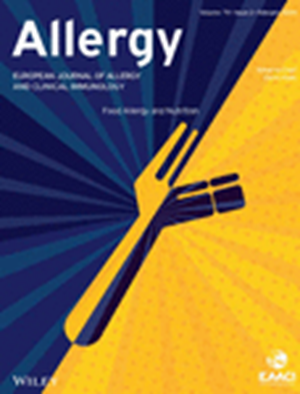Anti-KIT Barzolvolimab for Chronic Spontaneous Urticaria.
IF 12.6
1区 医学
Q1 ALLERGY
引用次数: 0
Abstract
BACKGROUND Chronic spontaneous urticaria (CSU) is characterized by mast cell (MC)-mediated wheals and/or angioedema without identifiable triggers and is driven by MC activation. Barzolvolimab-a monoclonal anti-KIT antibody-depletes MCs by inhibiting activation of KIT by stem cell factor. We evaluated multiple ascending doses in patients with CSU. METHODS Phase 1b double-blind placebo-controlled trial (NCT04538794) in adults with moderate-to-severe (urticaria activity score over 7 days [UAS7] ≥ 16) antihistamine-refractory CSU treated with intravenous barzolvolimab for 12 weeks with a 12-week follow-up in four sequentially enrolled cohorts (randomized 4:1 barzolvolimab:placebo): 0.5 mg/kg, Q4W (n = 9); 1.5 mg/kg, Q4W (n = 8); 3 mg/kg, Q8W (n = 9); and 4.5 mg/kg, Q8W (n = 9). Primary and secondary objectives were safety and disease activity (UAS7 and urticaria control test [UCT]). Pharmacokinetics and pharmacodynamics were assessed. RESULTS Patients had high mean (range) baseline CSU activity, with UAS7 = 29.6 (16.3-42.0) for barzolvolimab-treated, UAS7 = 35.8 (19.0-42.0) for placebo-treated, and 44% prior omalizumab use. Multiple doses of barzolvolimab were well tolerated. Hair color change was the commonest adverse event in barzolvolimab-treated patients. Across barzolvolimab doses, rapid symptom reduction within 1 week was observed and sustained during 12 weeks; 71% of patients achieved a well-controlled (UAS7 ≤ 6) response and 57% a complete response (UAS7 = 0). Additionally, 77% of barzolvolimab-treated patients achieved a well-controlled response (UCT ≥ 12) and 43% a complete response (UCT = 16) by Week 12. The kinetics of disease activity paralleled tryptase suppression, indicative of MC inhibition. Patients with and without prior omalizumab treatment responded similarly. CONCLUSIONS This study supports barzolvolimab as a promising treatment for CSU.抗kit Barzolvolimab治疗慢性自发性荨麻疹。
背景:慢性自发性荨麻疹(CSU)以肥大细胞(MC)介导的荨麻疹和/或血管性水肿为特征,无可识别的诱因,由肥大细胞(MC)激活驱动。barzolvolimab是一种单克隆抗KIT抗体,通过抑制干细胞因子对KIT的激活来消耗MCs。我们评估了CSU患者的多次上升剂量。方法1b期双盲安慰剂对照试验(NCT04538794),在4个顺序入组队列(barzolvolimab:安慰剂,随机4:1)中,静脉注射barzolvolimab治疗12周的中重度(荨麻疹活动评分超过7天[UAS7]≥16)抗组胺难治性CSU成人患者,0.5 mg/kg, Q4W (n = 9);1.5 mg/kg, Q4W (n = 8);3 mg/kg, Q8W (n = 9);4.5 mg/kg, Q8W (n = 9)。主要和次要目标是安全性和疾病活动性(UAS7和荨麻疹对照试验[UCT])。评估药代动力学和药效学。结果患者基线CSU平均(范围)活性较高,barzolvolimab组的UAS7 = 29.6(16.3-42.0),安慰剂组的UAS7 = 35.8 (19.0-42.0), omalizumab组的UAS7 = 44%。多剂量barzolvolimab耐受性良好。发色改变是巴唑利单抗治疗患者中最常见的不良事件。barzolvolimab剂量在1周内观察到症状迅速减轻,并持续12周;71%的患者获得良好控制(UAS7≤6)缓解,57%的患者获得完全缓解(UAS7 = 0)。此外,77%的barzolvolimab治疗患者在第12周达到了良好的控制缓解(UCT≥12),43%的患者达到了完全缓解(UCT = 16)。疾病活动的动力学与胰蛋白酶抑制平行,表明MC抑制。接受和未接受奥玛珠单抗治疗的患者的反应相似。结论本研究支持barzolvolimab作为一种有前景的治疗CSU的药物。
本文章由计算机程序翻译,如有差异,请以英文原文为准。
求助全文
约1分钟内获得全文
求助全文
来源期刊

Allergy
医学-过敏
CiteScore
26.10
自引率
9.70%
发文量
393
审稿时长
2 months
期刊介绍:
Allergy is an international and multidisciplinary journal that aims to advance, impact, and communicate all aspects of the discipline of Allergy/Immunology. It publishes original articles, reviews, position papers, guidelines, editorials, news and commentaries, letters to the editors, and correspondences. The journal accepts articles based on their scientific merit and quality.
Allergy seeks to maintain contact between basic and clinical Allergy/Immunology and encourages contributions from contributors and readers from all countries. In addition to its publication, Allergy also provides abstracting and indexing information. Some of the databases that include Allergy abstracts are Abstracts on Hygiene & Communicable Disease, Academic Search Alumni Edition, AgBiotech News & Information, AGRICOLA Database, Biological Abstracts, PubMed Dietary Supplement Subset, and Global Health, among others.
 求助内容:
求助内容: 应助结果提醒方式:
应助结果提醒方式:


